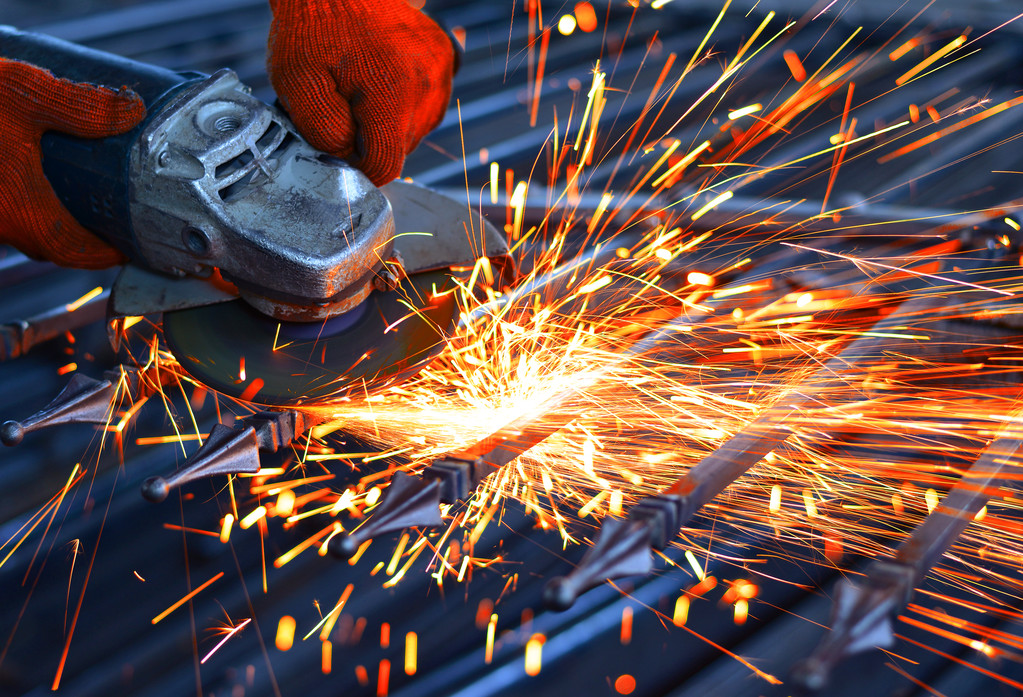Development and Application of Ultra-High Speed Grinding Technology
Ultra-high-speed grinding can not only greatly improve the grinding efficiency, but also effectively improve the processing quality. It is one of the most important development directions of today's grinding technology.
Ultra-high-speed grinding and efficient deep grinding
Compared with the previous ordinary grinding, high-speed grinding can be called high-speed grinding when the linear speed of the grinding wheel is Vs>45m/s. As early as the 1960s, Vs had been increased to 60m/s, and in the 1970s, it was increased to 80m/s, but in the next ten years, due to the constraints of the grinding wheel rotational rupture speed and the problem of workpiece burns, the linear speed of the grinding wheel did not increase. improvement. Until the late 1980s, with the wider application of cubic boron nitride (CBN) grinding wheels, and more in-depth research on the grinding mechanism, it was found that under the condition of high removal rate, with the increase of the grinding wheel linear speed Vs , the grinding force drops sharply in a certain interval before and after Vs=100m/s, this trend will continue with the further increase of the grinding rate, and the surface temperature of the workpiece will also drop. That is to say, after passing the grinding amount area where thermal damage occurs, the further increase of grinding amount will not only not aggravate thermal damage, but make thermal damage no longer occur, so as to develop ultra-high-speed grinding and high-efficiency grinding. Deep grinding has laid a theoretical foundation.
Although there is no strict limit for ultra-high-speed grinding, the grinding with grinding wheel linear speed Vs>150m/s is usually called ultra-high-speed grinding. Generally speaking, ultra-high-speed grinding has the following advantages:
High grinding efficiency and low grinding wheel wear
The higher the grinding speed is, the more abrasive grains are involved in cutting per unit time, the more abrasive debris is removed, and the feed speed of the workpiece should be proportional to the 1.13th power of the linear speed of the grinding wheel, so ultra-high-speed grinding will cause Grinding efficiency is greatly improved. Correspondingly, the grinding force on a single abrasive grain during ultra-high-speed grinding is greatly reduced, thereby reducing the wear of the grinding wheel. Many experiments have shown that when the grinding force is constant, the linear velocity Vs of the grinding wheel is increased from 80m/s to 200m/s, the grinding efficiency is increased by 2.5 times, and the life of the CBN grinding wheel is also extended by one time.
Small grinding force and high machining accuracy
Since the thickness of the grinding chips becomes thinner during ultra-high-speed grinding, the normal grinding force will decrease significantly with the increase of Vs under the condition of constant grinding efficiency (the normal grinding force when Vs is 200m/s is only 46% at 80m/s), thereby reducing the deformation of the process system. In addition, the excitation frequency of ultra-high-speed grinding is much higher than the natural frequency of the process system, which will not cause resonance. The combined result is an increase in grinding accuracy.
Good surface quality of workpiece
Experiments show that under certain other conditions, when the linear speed of the grinding wheel increases from 33m/s to 200m/s, the grinding surface roughness decreases from Ra2.0 acid to Ra1.1 acid. Since a large amount of grinding heat will be taken away by the grinding debris in the ultra-high-speed grinding process, the proportion of the incoming workpiece is very small, not only is it difficult to cause surface burns, but also the depth of the surface residual stress layer is also reduced.
In addition, ultra-high-speed grinding can also achieve ductile grinding of hard and brittle materials, and also has a good grinding effect on hard-to-grind materials such as high plasticity. Therefore, industrialized countries are competing for development, especially Germany, Japan, and the United States. Rapid development. According to reports, the German Aachen University of Technology has completed the experiment of the grinding wheel linear speed Vs=400m/s, and is now carrying out the experiment with the target of 500m/s. German companies such as GruhringAutomation, Schandt, Kapp have successively launched ultra-high-speed grinding machines. Japan is very effective in practical grinding, and the ultra-high-speed grinding machines with Vs=200m/s produced by Toyota Koki and other companies have been put into practical industrial applications. The ultra-high-speed grinder produced by EdgetekMachine in the United States is also famous for its single-layer CBN grinding wheel. At CIMT2001, Hunan University of China exhibited CNC high-speed cam grinding machine CNC8312, the linear speed of its CBN grinding wheel can reach 120m/s.
The ultra-high-speed CNC cylindrical grinder GZ32P launched by Japan's Toyota Koki several years ago has a maximum linear speed of 200m/s. When it uses a vitrified bond CBN grinding wheel to grind the reducer parts (hardened steel made of HRC58) as shown in Figure 2 at a grinding wheel linear speed of 160m/s, the workpiece revolution is 1000r/min, and the machining allowance △ =0.125mm. The obtained processing results are: the processing time is 72s, the roundness of the workpiece is 1.2 acid, and the surface roughness is Rz1.9 acid. Compared to plunge grinding with conventional grinding wheels, both machining time and workpiece roundness errors are more than halved.
Creep feed grinding is characterized by a large depth of cut and a low working feed rate, while the so-called high-efficiency deep grinding (High Efficiency Deep Grinding) is to apply a high-speed CBN grinding wheel to the creep-feed grinding with a high cutting rate, resulting in High-efficiency deep grinding technology integrating high grinding wheel speed (Vs=80~250m/s), fast working feed rate (0.5~10m/min) and large depth of cut (0.1~30mm). It has a very high removal rate and is especially suitable for full depth of cut single-stroke grinding of grooved parts. Figure 3 shows the PROFIMATMT series of plane and forming CNC grinding machines exhibited by German BLOHM company at CIMT2003. The three linear motions all use AC servos, ball screws and rolling guides. The maximum power of the grinding wheel spindle is 60kW, and the maximum linear speed of the grinding wheel is 170m/s. This grinding machine can be used for efficient deep grinding.
Several key technologies of ultra-high-speed grinding
The process system of grinding is "grinding machine-workpiece-grinding tool", and the key technology of natural ultra-high-speed grinding is also inseparable from the grinding machine, grinding wheel, grinding process and grinding fluid.
Research on the Mechanism and Technology of Ultra-High Speed Grinding
The research on the mechanism of ultra-high-speed grinding at home and abroad is not comprehensive, and it is necessary to further reveal the essence of various grinding processes and grinding phenomena. Grind the database to accelerate the pace of its application. The simulation of the grinding process by computer is helpful for the above research, and a virtual grinding machine can establish a realistic grinding environment.
Superabrasive grinding wheel and its dressing
Ultra-high-speed grinding wheel is to consolidate one or more layers of super-hard abrasives on the substrate, so it is further divided into two categories: multi-layer dressable and single-layer abrasive wheels. The superabrasives used are CBN except that the hard and brittle materials are diamond. In addition to having sufficient strength to withstand huge centrifugal force, the matrix of ultra-high-speed grinding wheels should also have high elastic modulus/density ratio and low thermal expansion coefficient. Currently, the commonly used material is high-strength alloy steel. Materials with better properties such as strength aluminum alloy and beryllium are used as the matrix. Japan has used a carbon fiber composite material CFRP as the matrix of ultra-high-speed grinding wheels. In addition, the shape design of the ultra-high-speed grinding wheel base is also critical.
The multi-layer dressable superhard grinding wheel has three kinds of binders: resin, metal and ceramic. Among them, the vitrified bond grinding wheel has porosity, and the bond is brittle. It can be trimmed with diamond rollers, and the shaping and sharpening can generally be completed at one time. There is also a new type of porous vitrified CBN grinding wheel, which can enhance the natural porosity through artificially induced pores. This grinding wheel will introduce more grinding fluid and facilitate chip evacuation, so that it can grind both high hardness and high hardness. Grinds medium-hard ferrous materials. Therefore, in ultra-high-speed grinding, the ultra-hard abrasive grinding wheel with vitrified bond is used more.
Dressing of resin-bonded or metal-bonded superabrasive grinding wheels is difficult, and shaping and sharpening need to be carried out separately. The dressing of superabrasive grinding wheels, especially on-line dressing, is still a research hotspot so far. The online electrolytic dressing (ELID) method suitable for metal-bonded superabrasive grinding wheels developed by the Japanese more than ten years ago has a great impact on the development of ultra-precision mirror grinding. played a role. The laser dressing method currently under study is not only convenient for dressing resin or metal bond superabrasive grinding wheels, but also has a small heat-affected zone, low grinding wheel dressing loss, easy automation, high dressing efficiency, and great development prospects.
Single-layer superabrasive grinding wheel without dressing, there are two kinds of electroplating grinding wheel and (high temperature) welding grinding wheel. Due to the excellent properties of superabrasives, even single-layer abrasives have a long life. Among them, the manufacturing process of electroplating grinding wheel is relatively simple (the abrasive can be blunted and electroplating can be repeated for many times). In ultra-high-speed fine grinding and form grinding. The bonding strength between the abrasive and the substrate of the welding grinding wheel is particularly high, and the exposed height of the abrasive grains reaches 60~70%, so the chip space is large and the abrasive grains can obtain a sharper appearance. It is reported that the linear speed of the welding grinding wheel abroad can reach 500m/s .
Spindle system and feed system of ultra-high-speed grinder
The overall structure and basic large parts of the ultra-high-speed grinder must have high dynamic and static stiffness, and the finite element method is usually used for analysis and optimization. The safety protection of the machine tool is also very important, but the most important thing is the spindle system and the feed system.
Spindle system
Increasing the linear speed of the grinding wheel is mainly to increase the speed of the grinding wheel. The maximum speed of the spindle of the ultra-high-speed grinding machine is above 10000r/min, and the transmitted grinding power is often tens of kilowatts. Therefore, the spindle system is required to have good rigidity, high rotation accuracy and low temperature rise. ,Low power consumption. In recent years, ultra-high-speed grinders have increasingly used an electric spindle that integrates the motor and the main shaft. The bearings used are mainly oil-air lubricated ceramic ball angular contact ball bearings and hydrodynamic and hydrostatic bearings. The latter are mostly used in outer-circle ultra-high-speed grinder. Although the magnetic bearing has good high-speed performance and high precision, it is expensive and has problems of heat generation and magnetic leakage, so it is still rarely used. The vibration caused by the dynamic unbalance of the high-speed rotating grinding wheel and the grinding wheel will seriously affect the grinding quality. In addition to the strict dynamic balance of the grinding wheel and the spindle system in advance, it should also be implemented during the grinding process of the machine tool. Automatic balance. In addition, it is necessary to pay full attention to the reliability of the connection between the grinding wheel and the spindle of the ultra-high-speed grinding machine.



